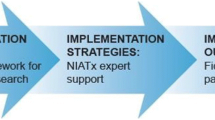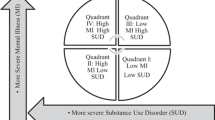Abstract
Integrated dual disorders treatment programs for people with severe mental illness and co-occurring substance use disorder have been implemented in a variety of community mental health center sites across the U.S. and in several other countries over the past 15 years. Consumers who receive services from programs that offer integrated dual diagnosis treatments that are faithful to evidence-based principles achieve significant improvements in their outcomes. Unfortunately, not all programs that attempt implementation are successful, and the quality of high-fidelity programs sometimes erodes over time. This article outlines implementation strategies that have been used by successful programs. As a general rule, success is achieved by involving all major participants (consumers, family members, clinicians, program leaders, and state or county mental health authorities) in the process and attending to the three phases of change: motivating, enacting, and sustaining implementation.
Similar content being viewed by others
REFERENCES
Abram, K., Teplin, L. (1991). Co-occurring disorders among mentally ill jail detainees: implications for public policy. American Psychologist, 46, 1036–1044.
Addiction Technology Transfer Center (2001). The Change Book: A Blueprint for Technology Transfer. Kansas City, Missouri: Addiction Technology Transfer Center National Office
Anthony, W.A. (1993). Recovery from mental illness: The guiding vision of the mental health service system in the 1990s. Psychosocial Rehabilitation Journal, 16(4), 11–23.
Barrowclough, C., Haddock, G., Tarrier, N., Lewis, S. W., Moring, J., O'Brien, R., Schofield, N., McGovern, J. (2001). Randomized controlled trial of motivational interviewing, cognitive behavior therapy, and family intervention for patients with comorbid schizophrenia and substance use disorders. American Journal of Psychiatry, 158(10), 1706–1713.
Bartels, S.J., Teague, G.B., Drake, R.E., Clark, R.E., Bush, P.W., & Noordsy, D.L. (1993). Substance abuse in schizophrenia: Service utilization and costs. Journal of Nervous and Mental Disease, 181, 227–232.
Batalden, P.B., Mohr, J.J. (1997). Building knowledge of health care as a system. Quality Management in Health Care, 5(3), 1–12.
Batalden, P.B., Stoltz, P.K. (1993). A framework for the continual improvement of healthcare: Building and applying professional and improvement knowledge to test changes in daily work. The Joint Commission Journal on Quality Improvement. 19:10, 424–445.
Bond, G.R., Vogler, K.M., Resnick, S.G., Evans, L.A., Drake, R.E., & Becker, D.R. (2001). Dimensions of supported employment: Factor structure of the IPS Fidelity Scale. Journal of Mental Health, 10(4), 383–393.
Carmichael, D., Tackett-Gibson, M., Dell, O. (1998). Texas Dual Diagnosis Project Evaluation Report 1997-1998. College Station, Texas: Texas A&M University, Public Policy Research Institute.
Caswell, J.S. (2001). Employment: A consumer's perspective. In D. R. Becker & M. Barcus (Eds.), Connections–State Partnership Initiative. (Spring/Summer, pp. 5). Fairfax, VA: Virginia Commonwealth University.
Clark, R.E. (2001). Family support and substance use outcomes for persons with mental illness and substance use disorders. Schizophrenia Bulletin, 27(1), 93–101.
Corrigan, P.W., Lickey, S.E., Campion, J., Rashid, F. (2000). Mental health team leadership and consumers' satisfaction and quality of life. Psychiatric Services 51 781–785.
Cuffel, B.J. (1996). Comorbid substance use disorder. Prevalence. patterns of use, and course. In Drake RE and Mueser KT, (Eds.) Dual Diagnosis of Major Mental Illness and Substance Disorder: II. Research and Clinical Implications. San Francisco, CA: Josssey-Bass, pp. 93–105.
Davis, D.A., Thomson, M.A., Oxman, A.D., Haynes, B. (1992). Evidence for the effectiveness of CME:Areview of 50 randomized controlled trials. Journal of the American Medical Association, 268(9), 1111–1117.
Deegan, P.E. (1988). Recovery: The lived experience of rehabilitation. Psychosocial Rehabilitation Journal. 11, 11–19.
Dickey, B., Azeni, H. (1996). Persons with dual diagnosis of substance abuse and major mental illness: Their excess costs of psychiatric care. American Journal of Public Health, 86, 973–977.
Dixon, L., Haas, G., Weiden, P., Sweeney, J., Frances, A. (1990). Acute effects of drug abuse in schizophrenic patients: Clinical observations and patients' self-reports. Schizophrenia Bulletin, 16(1), 69–79.
Drake, R.E., Brunette, M.F. (1998). Complications of severe mental illness related to alcohol and other drug use disorders. In M. Galanter (Ed.). Recent Developments in Alcoholism. Volume XIV, Consequences of Alcoholism (pp. 285–299). New York: Plenum Publishing Company.
Drake, R.E., Goldman, H.H., Leff, H.S., Lehman, A.F., Dixon, L., Mueser, K.T., Torrey, W.C. (2001). Implementing evidence-based practices in routine mental health settings. Psychiatric Services, 52, 197–182.
Drake, R.E., Mercer-McFadden, C., Mueser, K.T., McHugo, G.J., & Bond, G.R. (1998). Review of integrated mental health and substance abuse treatment for patients with dual disorders. Schizophrenia Bulletin, 24(4), 589–608.
Fox, L. (1998). Surviving and thriving with a dual diagnosis. Understanding Stress Anxiety and Depression, 2, 5–7.
Frese, F.J., Stanley, J.D., Kress, K., Vogel-Scibilia, S. (2001). Integrating evidence-based practices and the recovery model. Psychiatric Services, 52(11), 1462–1468.
Goldman, H.H., Ganju, V., Drake, R.E., Gorman, P.G., Hogan, M., Hyde, P. S., & Morgan, O. (2001). Policy implications for implementing evidence-based practices. Psychiatric Services, 52(12), 1591–1597.
Green, L., Krueter, M. (1991). Application of Precede/Proceed in Community Settings: Health Promotion Planning: An Educational and Environmental Approach.Mountain View, Calif.: Mayfield Publishing Co.
Green, L., Kreuter, M., Deeds S., Partridge K. (1980). Health Education Planning: A Diagnostic Approach. Palo Alto, CA: Mayfield Press.
Green, V.L. (1996). The resurrection and the life. American Journal of Orthopsychiatry, 66, 12–16.
Joint Commission on Accreditation of Healthcare Organizations (1995). Cycle for Improving Performance: A Pocket Guide. OakBrook Terrace, Il: Joint Commission on Accreditation of Healthcare Organizations
Langley, G.J., Nolan, K.M., Nolan, T.W., Norman, C.L., Provost, L.P.(1996). The Improvement Guide: A Practical Approach to Enhancing Organizational Performanc. San Francisco: Jossey Bass Publishers.
Liberman, R.P., Eckman, T.A. (1989). Dissemination of skills training modules to psychiatric facilities: Overcoming obstacles to the utilization of a rehabilitation innovation. British Journal of Psychiatry 155 (suppl. 5), 117–122.
McHugo, G.J., Drake, R.E., Teague, G.B., Xie, H. (1999). Fidelity to assertive community treatment and client outcomes in the New Hampshire Dual Disorders Study. Psychiatric Services, 50(6), 818–824.
Mead, S., Copeland, M.E. (2000). What recovery means to us: Consumers' perspectives. Community Mental Health Journal 36(3), 315–328.
Mueser, K.T., Bennett, M., Kushner, M.G. (1995). Epidemiology of substance abuse among persons with chronic mental disorders. In A.F. Lehman & L. Dixon (Eds.), Double Jeopardy: Chronic Mental Illness and Substance Abuse (pp. 9–25). New York: Harwood Academic Publishers.
Mueser, K.T., Corrigan, P.W., Hilton, D.W., Tanzman, B., Schaub, A., Gingerich, S., Essock, S.M., Tarrier, N., Morey, B., Vogel-Scibilia, S., Herz, M.I. (in press). Illness management and recovery: A review of the research. Psychiatric Services.
Mueser, K.T., Drake, R.E., Noordsy, D.L. (1998). Integrated mental health and substance abuse treatment for severe psychiatric disorders. Journal of Practical Psychiatry and Behavioral Health, 4(3), 129–139.
Mueser, K.T., Fox, L. (1998). Dual Diagnosis: How families can help. Journal of the California Alliance for the Mentally Ill, 9, 53–55.
Mueser, K.T., Fox, L. (2002). A family intervention program for dual disorders. Community Mental Health Journal, 38, 253–270.
Nelson, E.C., Batalden, P.B., Ryer, J.C. (Eds) (1998). Joint Commission Clinical Improvement Action Guide. Oakbrook Terrace, Illinois: Joint Commission on Accreditation of Healthcare Organizations.
Ohio SAMI Conference (June 7-8, 2001). Integrated Services for the Treatment of Co-occurring Disorders: Making it Work in Ohio. Der Dutchman Restaurant & Conference Center, Bellville, OH.
Phillips, S.D., Burns, B.J., Edgar, E.R., Mueser, K.T., Linkins, K.W., Rosenheck, R.A., Drake, R.E., & McDonell Herr, E.C. (2001). Moving assertive community treatment into standard practice. Psychiatric Services, 52, 771–779.
Prochaska, J.M., Prochaska, J.O., Levesque, D.A. (2001). Transtheoretical Approach to Changing Organizations. Administration and Policy in Mental Health 28(4): 247–61.
Ralph, R.O. (2000). Review of Recovery Literature: A Synthesis of a Sample of Recovery Recovery Literature 2000. Alexandria, VA: NASMHPD/National Technical Assistance Center for State Mental Health Planning.
Rapp, C.A. (1998). The Strengths Model. New York, NY: Oxford University Press, Inc.
Regier, D.A., Farmer, M.E., Rae, D.S., Locke, B.Z., Keith, S.J., Judd, L.L., Goodwin, F.K. (1990). Comorbidity of mental disorders with alcohol and other drug abuse. Journal of the American Medical Association 264, 2511–2518.
Rosenberg, S.D., Goodman, L.A., Osher, F.C., Swartz, M., Essock, S.M., Butterfield, M.I., Constantine, N., Wolford, G.L., Salyers, M. (2001a.). Prevalence of HIV, Hepatitis B, and Hepatitis C in people with severe mental illness. American Journal of Public Health, 91, 31–37.
Rosenberg, S.D., Mueser, K.T., Friedman, M.S., Gorman, P.G., Drake, R.E., Vidaver, R., Torrey, W.C., Jankowski, M.K. (2001b.). Developing effective treatments for post-traumatic disorders among people with severe mental illness. Psychiatric Services, 52, 1453–1461.
Schoenwald, S.K., & Hoagwood, K. (2001). Effectiveness, transportability, and dissemination of interventions: What matters when? Psychiatric Services, 52, 1190–1197.
Schulberg, H.C., Katon, W., Simon, G.E., Rush, A.J. (1998). Treating major depression in primary care practice: An update of the agency for health care policy and research practice guidelines. Archives of General Psychiatry 55(12), 1121–1127.
Soumerai, S.B. (1998). Principles and uses of academic detailing to improve the management of psychiatric disorders. International Journal of Psychiatry in Medicine, 28(1), 81–96.
Soumerai, S.B., Avorn, J. (1990). Principles of educational outreach (academic detailing) to improve clinical decision making. Journal of the American Medical Association 263(4), 549–556.
Spaniol, L, Zipple, A., Cohen, B. (1991). Managing innovation and change in psychosocial rehabilitation: Key principles and guidelines. Psychosocial Rehabilitation Journal 14(3), 27–38.
Torrey, W.C., Drake, R.E., Dixon, L., Burns, B.J., Flynn, L., Rush, A.J., Clark, R.E., Klatzker, D. (2001). Implementing evidence-based practices for persons with severe mental illnesses. Psychiatric Services, 52, 45–50.
Torrey, W.C., Wyzik, P.F. (2000). The recovery vision as a service improvement guide for community mental health center providers. Community Mental Health Journal, 36(2), 209–216.
U.S. Department of Health and Human Services (1999). Mental Health: A Report of the Surgeon General. Rockville, MD: U.S. Department of Health and Human Services, Substance Abuse and Mental Health Services Administration, Center for Mental Health Services, National Institutes of Health, National Institute of Mental Health.
Author information
Authors and Affiliations
Rights and permissions
About this article
Cite this article
Torrey, W.C., Drake, R.E., Cohen, M. et al. The Challenge of Implementing and Sustaining Integrated Dual Disorders Treatment Programs. Community Ment Health J 38, 507–521 (2002). https://doi.org/10.1023/A:1020888403586
Issue Date:
DOI: https://doi.org/10.1023/A:1020888403586




